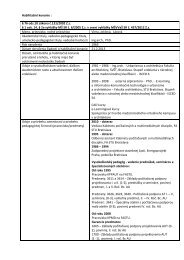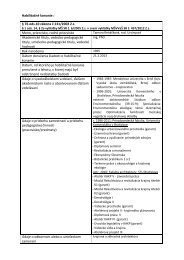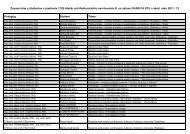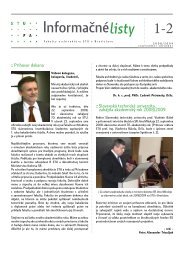ALFA 3-4/2005 - Fakulta architektúry STU
ALFA 3-4/2005 - Fakulta architektúry STU
ALFA 3-4/2005 - Fakulta architektúry STU
Create successful ePaper yourself
Turn your PDF publications into a flip-book with our unique Google optimized e-Paper software.
Ročník 9<br />
3-4 / <strong>2005</strong> ARCHITEKTONICKÉ LISTY FA <strong>STU</strong><br />
Exposure to bright morning light has been shown to reduce<br />
agitation among elderly patients with dementia. It has also been<br />
shown that patients in bright rooms have a shorter length of stay<br />
compared to patients in dull rooms. Beauchemin and Hays (1996)<br />
found that patients hospitalised for severe depression reduced<br />
their stays by an average of 3.67 days if assigned to a sunny<br />
rather than a dull room overlooking spaces in shadow.<br />
The amount of sunlight in a hospital room modifies a patient’s<br />
psychosocial health, quantity of analgesic medication used, and<br />
pain medication cost. Patients exposed to an increased intensity<br />
of sunlight experienced less perceived stress, less pain, took<br />
22 percent less analgesic medication per hour and had 20 percent<br />
less pain medication costs. Thus, an important consideration while<br />
designinghospital layouts may be to optimise exposure to morning<br />
light in patient rooms by using an east-facing orientation.<br />
Depression might be worsened by architectural designs that block<br />
or sharply reduces natural daylight in patient rooms.<br />
Reduce exposure to negative distraction<br />
One of the most frequent negative distractions in Hospitals is<br />
noise. Hospital buildings often have sound-reflective surfaces that<br />
reverberate noise instead of absorbing it. This can lead to sleep<br />
loss and high blood pressure in patients and to fatigue and stress<br />
in staff, resulting in more errors. It can also reduce speech<br />
intelligibility, again causing more errors. People have to be able to<br />
talk and understand each other properly, reducing possible<br />
misunderstandings. Noise reduction is vital in such areas as<br />
intensive therapy units, critical care units, neonatal intensive care<br />
units, wards etc. Good acoustics mean positive staff and positive<br />
patients. Hospitals are used to be excessively noisy for two<br />
general reasons. First, noise sources are numerous, often<br />
unnecessarily so, and many are loud.<br />
Second, environmental surfaces floors, walls, ceilings usually are<br />
hard and sound reflecting, not soundabsorbing, creating poor<br />
acoustic conditions. Sound reflecting surfaces cause noise<br />
topropagate considerable distances, travelling down corridors and<br />
into patient rooms, and adversely affecting patients and staff over<br />
larger areas. Sound-reflecting surfaces typical of hospitals cause<br />
sounds to echo, overlap, and linger or have long reverberation<br />
times.<br />
Research of Ulrich, Lawson, & Martinez (2003) clearly shows that<br />
patients in single-bed rooms, compared to those with a roommate,<br />
are vastly more satisfied with the noise levels in and around their<br />
room. Noise levels are much lower in single-bed than multi-bed<br />
rooms. Studies of multi-bed rooms in acute care and intensive<br />
care units have shown that most noises stem from the presence<br />
of another patient (staff talking, staff caring for other patients,<br />
equipment, visitors, patient sounds such as coughing, crying out,<br />
- 39 -<br />
In multi-bed rooms, noises stemming from the presence of other<br />
patients often are the major cause of sleep loss. Far higher<br />
satisfaction with noise levels in single rooms is evident across all<br />
major patient categories and types of unit and across different age<br />
and gender groups.<br />
Design of corridor spaces reminds of a gallery.

















